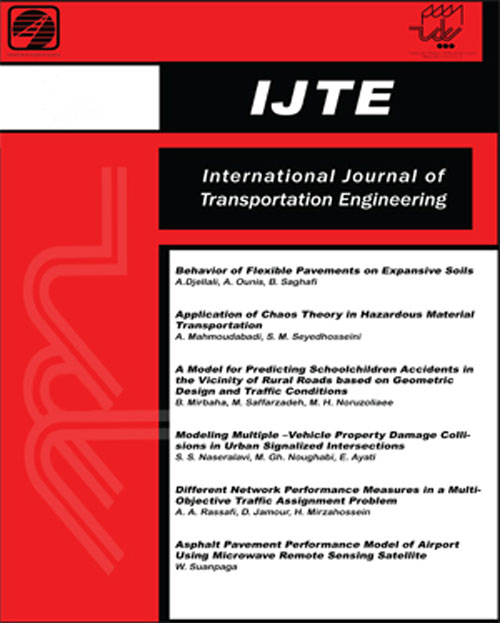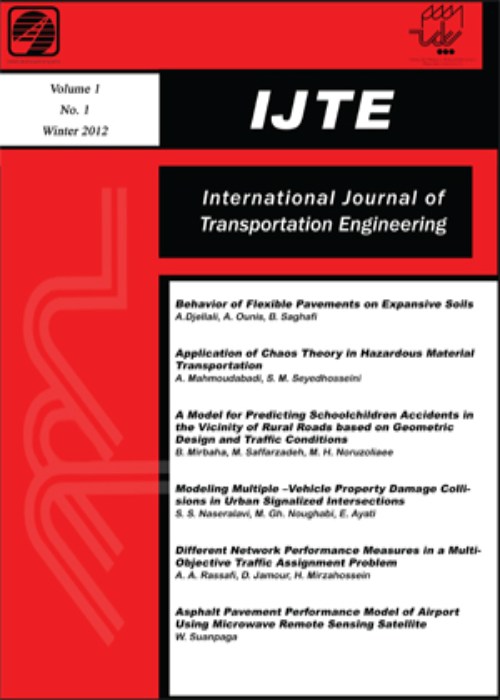فهرست مطالب

International Journal of Transportation Engineering
Volume:5 Issue: 2, Autumn 2017
- تاریخ انتشار: 1396/03/18
- تعداد عناوین: 6
-
-
Pages 103-117The study of various countries rail transportation indicators is an appropriate criterion for evaluating the existing performance of Iranian railways. The experiences of other countries can be used to improve the efficiency of Irans rail transportation. At the beginning of the study, in order to compare the Iranian railway performance with railways of other countries, various efficiency indicators have been defined. The comparison based on data from the International Union of Railways members in 2012. The Iranian railway performance indicators comparison with other countries around the world and in the Middle East and Central Asia show that the main priorities to meet the needs of Irans rail freight transportation are increasing the number of the locomotives, developing railway lines and increase efficiency of fleet. In order to evaluate the efficiency of each of the areas listed above, nonparametric method of data envelopment analysis DEA (modified Output-oriented BCC) has been used. Based on the obtained results, the Iranian railway rank is 23 among 66 countries of the world with efficiency of 51 percent and its rank is 9 among 14 countries of the Middle East and Central Asia with efficiency of 55 percent. The efficiency of Iran railway wagons is low and the annual ton-km can be increased from 22604 to 41136. At the end of the study, time series performance index of countries from 2000 to 2012 were studied. And over these years, Iran has always had a constant downward trend with efficiency of 30 percent.Keywords: Data Envelopment Analysis, freight transportation, rail transportation, efficiency indicators
-
Pages 119-136This paper aims to study the locomotive routing problem (LRP) which is one of the most important problems in railroad scheduling in view of involving expensive assets and high cost of operating locomotives. This problem is assigning a fleet of locomotives to a network of trains to provide sufficient power to pull them from their origins to destinations by satisfying a rich set of operational constraints and minimizing the total operational cost. This problem is the special application of vehicle scheduling and it is modeled by using the vehicle routing problem with time windows (VRPTW) to optimal assignment of locomotives to assembled trains. Almost all of the prior models were deterministic and an important issue, widely ignored in prior research in locomotive optimization, is the presence of significant sources of uncertainty in transit times, travel times and changes to the train schedule. Therefore, in this paper unlike most of the work where all the times are deterministic, uncertainty in travel time is considered. Because travel times in reality fluctuate due to a variety of factors and its understanding and management in transportation networks is very important. The concepts of fuzzy sets and fuzzy control systems are considered to model the uncertainty in travel times. Besides, a genetic algorithm (GA) with various heuristics is proposed to tackle the proposed model and its performance is evaluated in different steps on various test problems generalized from a set of instances in the literature. The computational experiments on data sets illustrate the efficiency and effectiveness of the proposed approach.Keywords: Locomotive Routing Problem, Vehicle Routing, Scheduling, Fuzzy Travel Time, Genetic Algorithm
-
Pages 137-165In this paper, an incentive scheme based on crashing lead time is proposed to coordinate a supplier-retailer supply chain (SC). In the investigated SC, the supplier applies a lot-for-lot replenishment policy to replenish its stock and determines the replenishment multiplier. Moreover, the transportation lead time is considered under the control of the supplier. The retailer as downstream member manages his inventory system according to the periodic review replenishment system (R, T). The review period (T) and order-up-to level (R) decisions along with the retail price are simultaneously optimized by the retailer. These decisions are made by the retailer influence the profitability of SC as well as the supplier's profitability. The investigated SC is modeled under three different decision making structures, i.e., (1) decentralized decision making model, (2) centralized decision making model, and (3) coordinated decision making model. By developing a lead time reduction policy as an incentive strategy, the pricing and periodic review replenishment decisions are coordinated. In the proposed incentive approach, the supplier by spending more cost and changing a fast transportation mode aims to crash the lead time in order to entice the retailer to accept the joint decision making strategy. In the suggested incentive scheme, two transportation modes (one slow and one fast) are supposed. Further, maximum and minimum lead time reduction, which are acceptable for both members, are determined. Moreover, a set of numerical examples along with a real case are carried out to demonstrate the performance and applicability of the developed models. The results demonstrate that the proposed incentive strategy is able to achieve channel coordination. Moreover, the results show the applicability of the developed coordination model under the high demand uncertainty. In addition, the proposed coordination model will fairly share the obtained profits between two SC members.Keywords: Transportation mode selection, lead time reduction, supply chain coordination, pricing, periodic review inventory system
-
Pages 167-182Increasing vehicle popularity and, in the meantime, traffic accidents, is one of the most important death factors these days. Many policies have been implemented to decrease accident injuries and damages, and to increase safety. Between three effective factors in accidents, including human, vehicle, and road, human factor is known as the most important one. Human behavior during driving is derived from personality characteristics which cognition of them can lead to determine their effects. The ability to detect hazardous situations on roads is mentioned as driver hazard perception which can cause more caution and, consequently, less accidents. In previous studies to investigate the hazard perception according to their cognitive properties drivers, usually descriptive statistics were used. But in this study, for the first time assuming that there is a relationship between personality characteristics and peoples hazard perception, the relationship is surveyed. In this way, 380 persons, having driving license, are surveyed using five factor personality features questionnaire (NEO), Trail making test in order to measure attention and concentration, and hazard perception tests for the first time. The obtained information from questionnaire and tests is analyzed using STATA. Then, linear regression model, including hazard perception parameter (as dependent variable) and personality characteristics, attention, and concentration parameters (as independent variables), is presented. In linear regression model, coefficient of determination is equal to 0.704 and p-value of some Coefficients are in significant intervals. These show that chosen independent variables explain and predict driver's hazard perception in an acceptable level. Also results show that personality characteristics like: Expectation, Fear of the future, extraversion, flexibility, conscientiousness, attention and concentration have meaningful relations and can be used for driver hazard perception prediction. An important application of this research to add psychology factors and hazard perception test in the process of certification driving test.Keywords: Personality characteristics, driving behavior, hazard perception tests, NEO questionnaire
-
Pages 183-195Intelligent Driver Model (IDM) is a well-known microscopic model of traffic flow within the traffic engineering societies. While it is a powerful technique for modeling traffic flows, the Intelligent Driver Model lacks the potential of accommodating the notion of drivers heterogeneous behavior whenever they are on roads. Concerning the above mentioned, this paper takes the lane to recognize the heterogeneity in drivers behavior based on Heterogeneity Vector. Heterogeneity vector is an integral part of a new model that holds the potential to provide a method that in turn can accommodate the effect of the above mentioned differentiation in the traffic pattern. The Intelligent Driver Model in combination to Heterogeneous vector results to Intelligent Driver Model Heterogeneous Calibration (IDMHC) which in turn has the capability to improve the accuracy of IDM calibration, and as a result, enhances its performance under real conditions of traffic systems. Following the pre-stated, the study formulates that, the heterogeneity vector, as an output of the computation block, will apply in the simulation of the traffic of vehicles. To validate the performance of the IDMHC model, NGSIM project has been applied. As such, the most notable contributions of this study are, presenting a new method for calibration of microscopic flow model based on individual trajectory data, depicting the differences among drivers based on the newly defined heterogeneity measure, and illustrating the differences among drivers shape, traffic patterns that are causing different distributions of macroscopic variables such as travel time. Based on the study, the results obtained depicts that the difference between the presumed values regarding the IDM parameters has a great difference when compared with the calculated values for each vehicle based on a 50% variance. These results have the likelihood to significantly affect the mode in which microscopic models simulate and predict the traffic situation.Keywords: Microscopic modeling, heterogeneity, driver behavior, intelligent driver model (IDM), traffic simulation
-
Pages 197-209The safety management of transportation system leads to decrease in a number of traffic accidents. Identification of the primary reasons in accident incidence is the initial step in controlling the crashes. The source of accidents is divided into 3 groups; namely, human, environment and traffic. Due to the complex nature of traffic accidents, Multi-Criteria Decision-Making (MCDM) methods can be considered as an efficient approach. The main objective of the paper was to use analytical network process (ANP) to evaluate the interaction of human, traffic and road related parameters in occurrence of accidents. ANP is the extended form of analytical hierarchy process (AHP). AHP simulates a decision problem into a hierarchy consists of a goal, decision criteria, and alternatives, while the ANP structures that as a network. Next step is to use pair wise comparisons to calculate the weights of the components of the structure, and to rank the alternatives in the decision. The power of the ANP lies in its use of ratio scales to capture all kinds of interactions and make accurate predictions. In this paper, using ANP structure, instead of pair wise comparison made by experts opinion in calculation of the weight of components; statistic analysis as well as frequency of effective parameters in accident occurrence, were utilized where statistics was available. This was resulted in more accurate outcomes. Sub-urban accidents data in the length of 945 km of Hamedan province in three-year period was considered as a case study. As a result, although most of the researchers are of the idea that the human plays a crucial role in crash occurrence, road factors had higher priority. Factors such as curvature and grade were more effective than human characteristics. Furthermore, it was concluded that, Condition curvature (0-100) degree per kilometer and grade (0-3%) had higher risk of accidents.Keywords: Traffic accidents, Accident parameters, Multi-Criteria Decision-Making, Human factors, Analytical Hierarchy Process


